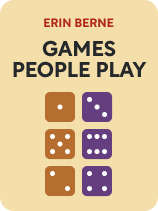

This article is an excerpt from the Shortform book guide to "Games People Play" by Eric Berne. Shortform has the world's best summaries and analyses of books you should be reading.
Like this article? Sign up for a free trial here .
What is a transaction in the context of Eric Berne’s Transactional Analysis? What are the three ego states?
“Transactions” are Eric Berne’s “basic unit” of social interaction. We gain social recognition through transactions, and we can analyze transactions by looking at the ego states that are involved (the parent, the adult, and the child).
In this article, we’ll define transactions and cover the main types of games in Transactional Analysis.
An Exchange Is One Segment of an Interaction
Eric Berne’s Games People Play is a Transactional Analysis of patterns of social interaction. For Berne, a “transaction” is the basic unit of social interaction. Think of it as one back-and-forth between individuals: ”So, how about that weather? / Yup, sure is raining.” From here on, we’ll use exchange to refer to a “transaction” because it’s more descriptive.
Berne observes that when two people are together in a social setting, one will inevitably engage the other, and the second will respond. For example, someone sitting next to you in the optometrist’s waiting room says, “Hello, what are you here for?” and you respond, “Hi, just my yearly check-up. How about you?” This is one exchange.
(Shortform note: Berne receives criticism similar to that of Freud: that many of his ideas aren’t really scientific. But maybe Berne wasn’t trying to “prove” exchanges or transactions are real, so much as he was just describing a phenomenon. Think of “bars” as used in writing music: They aren’t necessarily real, but they are a useful tool. They enable us to segment musical expression, making it easier to analyze. Exchanges enable us to segment social interaction, making it easier to analyze.)
Ego States Determine an Exchange’s Type
From here, Berne lays out the types of exchanges. Each person involved in an exchange acts from their parent, child, or adult state. In Berne’s model, the exchange changes type depending on whether the initiator and the responder respect each other’s states.
- For example, chatting with a colleague is a balanced, adult-to-adult exchange.
- Or, say your boss gets frustrated with you (her parent to your child) for missing an important deadline, and you respond in fearful submission (your child to her parent)—still balanced.
- Now imagine that you’re sick of her, so you talk down to her. This breaks the balance—she spoke as a parent to a child, but then your condescension did the same to her—and disrupts communication.
There are a few different kinds of exchanges taking place here. We’ve grouped them into two categories, basic and complex.
Basic Exchanges
A basic reciprocal exchange is a normal, healthy back-and-forth. The exchange is friendly, follows good manners, and both people fulfill each other’s need for recognition. Berne also calls these “complementary” exchanges.
Reciprocal exchanges follow parallel lines of communication between states—a parent speaks to a child, and the child speaks back to the parent. Adult to adult, child to child, and so on. A typical T.A. diagram looks like this:
A basic disrupted exchange occurs when one person loses their cool and responds antagonistically. Anger, fear, annoyance, and so on, can all cause this. If you’re conversing adult-to-adult with a colleague, then accidentally offend them, Berne would say they’ve shifted mind states—probably to child or parent.
For example, say you ask your significant other to do the laundry this time, but they start complaining about how they always have to and really hate it (imagine some pouting, too). You spoke adult to adult, but they responded as a child to your parent, disrupting the parallel lines of communication. Here’s how Berne diagrammed disrupted exchanges:
(Shortform note: Some businesspeople have used Berne’s transactional model to aid workplace communication. And it works independently of psychoanalytic interpretations—just ego states and exchanges are enough to get a handle on where a communication breakdown comes from. Our guide to Crucial Conversations teaches how to navigate sensitive topics with strategies like creating a safe environment, regulating your emotions, and understanding each other by sharing your stories. This is how, as Berne would say, you can keep communication adult-to-adult: rational, respectful, and balanced.)
Complex Exchanges
Berne outlines multiple complex exchanges, but they aren’t all relevant to games. We’ve distilled out the one that’s key, which he labels “ulterior.” We’ll use deceptive as a more precise term.
Deceptive Exchanges occur when the initiator has a concealed motive, Berne says. On the surface the exchange looks normal, but on the psychological level it’s dishonest. The initiator tries to manipulate the respondent, consciously or unconsciously, into behaving a certain way.
For example, a copywriter writes marketing copy from their adult state but targets your emotional self—your parent or child. On the surface level, it looks like an adult making a pitch to an adult. On the psychological level, the copywriter aims to bypass the rational adult.
(Shortform note: Outside the realm of one-on-one communication, Berne’s notion of deceptive exchanges seems to map well onto modern propaganda. Much of what we see online is based on algorithmic calculation of our preferences—of what will pique our emotions. Algorithms present us with personalized advertisements and content that seems like an offering to our adult: It fits our tastes, our values, and so on. But in truth, there’s a concealed motive. It’s all meant to grab our attention and get us to scroll, or to buy something. Recognizing this, and training yourself to notice when an apparently harmless offering may be a deceptive exchange, can help you to reclaim your attention and live a more focused life.)
Sequences of Exchanges Flow One to the Next
Now that we know the types of exchanges, let’s look at how exchanges work in sequence.
According to Berne, a social interaction is a string of exchanges. Think of this like the links in a chain: A cues B, B cues C, C cues D, and so on. There are two rules that govern whether the chain continues or breaks off, Berne says.
Rule #1: When two people communicate back and forth in a respectful, healthy way, an interaction can theoretically continue without end. This is a string of reciprocal exchanges, where each person recognizes the other (remember that this refers to “stroking”), and their mind states remain parallel.
For example, two friends enjoying a normal conversation could continue indefinitely, so long as they respect each other’s states. In this case, it’s adult to adult. The same is true of any other pairing—child to parent, parent to adult, and so on—so long as neither gets upset and disrupts the parallel states.
(Shortform note: While Berne says that “in principle” an exchange could go on forever, it’s worth noting that this is never actually the case. Continuing his hunger metaphor, each of us needs a different amount of social contact to feel “full.” In Quiet, Susan Cain details how extroverts and introverts need very different levels of social stimulation: Extroverts derive energy from socialization, while introverts can only socialize so much before needing to recharge. Berne doesn’t discuss this, but the idea of a difference in “appetite” for socialization seems to fit well with his analogy of hunger. The lower your appetite, the less you’ll seek interactions that last for a long time.)
Rule #2: If one person (call them B) loses their cool, that disrupts the interaction and communication breaks down. For example, it’s an adult-to-adult conversation until A accidentally offends B. B gets fired up, moving into their parent state, and talks down to A.
Berne doesn’t describe any one solution to disrupted communication. Rather, there are two possibilities once communication breaks down:
- One or both participants can realize the breakdown and shift back to adult rationality, ideally finding the humor in their inappropriate behavior, or…
- One participant can go along with the other’s shift. For example, A might get emotionally swept up after B gets offended, and respond from the child state that B talked down to. According to Berne, this results in fighting, until the two can restabilize their emotions or simply part ways.
(Shortform note: If you’ve ever experienced an abrupt, negative shift in a conversation, then you’ve seen a disrupted exchange firsthand. Here, Berne’s concept is a useful heuristic for recognizing a communication breakdown, and it can be combined with strategies like those from Nonviolent Communication to resolve conflicts. For example, expressing your feelings and linking them to your basic needs can help people recognize your shared humanity, showing them how to better respond to you.)

———End of Preview———
Like what you just read? Read the rest of the world's best book summary and analysis of Eric Berne's "Games People Play" at Shortform .
Here's what you'll find in our full Games People Play summary :
- The many ways that we relate to one another through “games”
- Why you might be missing out on the fulfillment of game-free living
- How to identify and overcome unhealthy games






